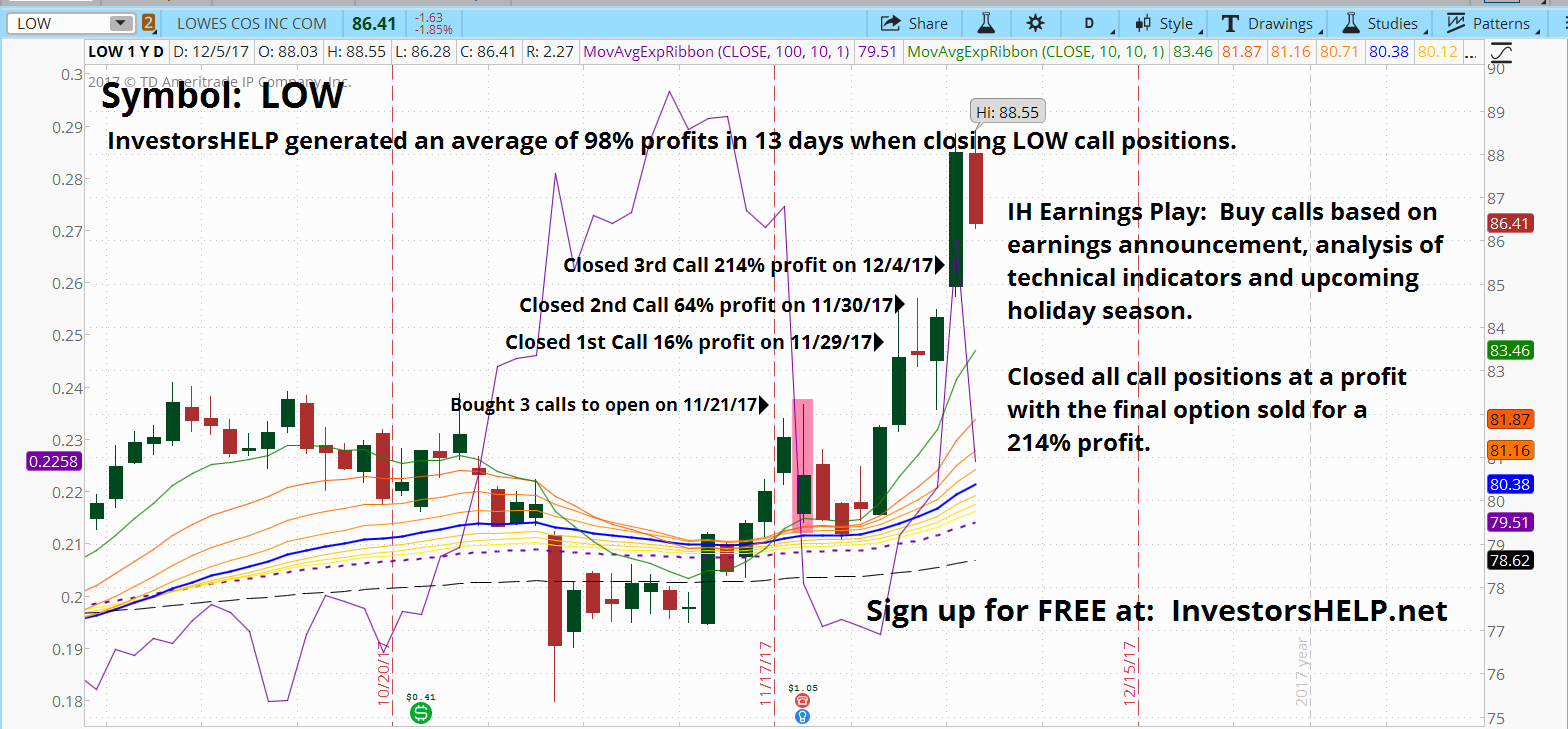Hello Fellow Traders and Investors,
The market seemed very quiet today. So I thought this would be a great time to continue the blog topic Trader_Joe began a few days ago on options trading over earnings.
As Joe mentioned, in late November we researched companies with earnings in the near future. Lowes (LOW) had earnings pre-market on November 21st. The estimated earnings was $1.0284 and actual was reported at $1.05. Though price gapped down at the open, after taking into consideration that earnings exceeded the estimate, an analysis of our indicators and the upcoming holiday season, we decided to go into an earnings play on LOW.
As Joe mentioned, if we anticipate price moving up and volatility is high, generally we want to sell a put. If we anticipate price moving up and volatility is low, generally we want to buy a call. But this isn’t set in stone, as the case with LOW.
When selling a put, the maximum profit potential is limited to the amount of premium collected when the put is sold. The premium goes directly into your account. But when buying a call, the maximum profit is unlimited. After reviewing everything mentioned above and anticipating a large move up in price, we decided to buy calls on LOW.
On November 21, we bought 3 call options at $81.50 expiring 12/22/17.
As we said above, LOW price had gapped down at the open, but began to move up during the day. The next three days were red candles, which means the price of the stock closed lower than the open. We anticipated this being a possibility and that’s why we went with an option 30 days out instead of only a week or two.
We closed the first option on 11/29 with a 16% profit. We closed the second option with a 64% profit on 11/30. Price action on 12/4 began with a slight gap up and began climbing. We decided that this would be a great day to close our final option, which we did for a profit of 214%!
The take-away for a new trader is if you anticipate a stock price moving up, the general rule of thumb is to buy a call when volatility is low and to sell a put when volatility is high. This is not set in stone and other factors/analysis can lead tell the trader to place trades opposite the general rule.
We hope that you are finding this information on our trades helpful to you. These blog posts should especially be helpful to those of you who are newbies (new to trading) since there is so much to learn especially on trading options.
Happy Returns!
Trader Cindy
The market seemed very quiet today. So I thought this would be a great time to continue the blog topic Trader_Joe began a few days ago on options trading over earnings.
As Joe mentioned, in late November we researched companies with earnings in the near future. Lowes (LOW) had earnings pre-market on November 21st. The estimated earnings was $1.0284 and actual was reported at $1.05. Though price gapped down at the open, after taking into consideration that earnings exceeded the estimate, an analysis of our indicators and the upcoming holiday season, we decided to go into an earnings play on LOW.
As Joe mentioned, if we anticipate price moving up and volatility is high, generally we want to sell a put. If we anticipate price moving up and volatility is low, generally we want to buy a call. But this isn’t set in stone, as the case with LOW.
When selling a put, the maximum profit potential is limited to the amount of premium collected when the put is sold. The premium goes directly into your account. But when buying a call, the maximum profit is unlimited. After reviewing everything mentioned above and anticipating a large move up in price, we decided to buy calls on LOW.
On November 21, we bought 3 call options at $81.50 expiring 12/22/17.
As we said above, LOW price had gapped down at the open, but began to move up during the day. The next three days were red candles, which means the price of the stock closed lower than the open. We anticipated this being a possibility and that’s why we went with an option 30 days out instead of only a week or two.
We closed the first option on 11/29 with a 16% profit. We closed the second option with a 64% profit on 11/30. Price action on 12/4 began with a slight gap up and began climbing. We decided that this would be a great day to close our final option, which we did for a profit of 214%!
The take-away for a new trader is if you anticipate a stock price moving up, the general rule of thumb is to buy a call when volatility is low and to sell a put when volatility is high. This is not set in stone and other factors/analysis can lead tell the trader to place trades opposite the general rule.
We hope that you are finding this information on our trades helpful to you. These blog posts should especially be helpful to those of you who are newbies (new to trading) since there is so much to learn especially on trading options.
Happy Returns!
Trader Cindy

 RSS Feed
RSS Feed